中国文化与翻译 Chinese Culture and Translation
- 格式:ppt
- 大小:3.45 MB
- 文档页数:8
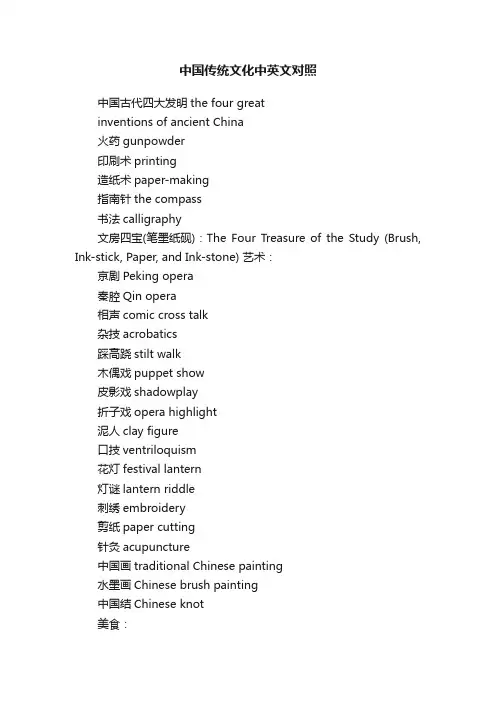
中国传统文化中英文对照中国古代四大发明the four greatinventions of ancient China火药gunpowder印刷术printing造纸术paper-making指南针the compass书法calligraphy文房四宝(笔墨纸砚):The Four Treasure of the Study (Brush, Ink-stick, Paper, and Ink-stone) 艺术:京剧Peking opera秦腔Qin opera相声comic cross talk杂技acrobatics踩高跷stilt walk木偶戏puppet show皮影戏shadowplay折子戏opera highlight泥人clay figure口技ventriloquism花灯festival lantern灯谜lantern riddle刺绣embroidery剪纸paper cutting针灸acupuncture中国画traditional Chinese painting水墨画Chinese brush painting中国结Chinese knot美食:小吃摊snack bar/snack stand月饼moon cake年糕rice cake油条deep-fried dough sticks豆浆soybean milk馒头steamed buns花卷steamed twisted rolls包子steamed stuffed buns拉面hand-stretched noodles馄饨wonton (dumplings in soup)豆腐tofu; bean curd麻花fried dough twist蛋炒饭fried rice with egg节日:春节:the Spring Festival元宵节:the Lantern Festival清明节:the Tomb-sweeping Day端午节:the Dragon-boat Festival中秋节:the Mid-autumn Day重阳节:the Double-ninth Day七夕节:the Double-seventh Day名著:《大学》The Great Learning《中庸》The Doctrine of the Mean 《论语》The Analects of Confucius 《孟子》The Mencius《孙子兵法》The Art of War《三国演义》Three Kingdoms《西游记》Journey to the West《红楼梦》Dream of the Red Mansions《水浒传》Heroes of the Marshes《山海经》The Classic of Mountains and Rivers 《资治通鉴》History as a Mirror《春秋》The Spring and Autumn Annals《史记》Historical Records《诗经》The Book of Songs《易经》The Book of Changes《礼记》The Book of Rites《三字经》Three-character Scriptures旅游景点:秦始皇陵the Mausoleum of Emperor Qinshihuang 兵马俑Terracotta Warriors and Horses大雁塔Big Wild Goose Pagoda丝绸之路the Silk Road敦煌莫高窟Mogao Grottoes华清池Huaqing Hot Springs五台山Wutai Mountain九华山Jiuhua Mountain蛾眉山Mount Emei泰山Mount Tai黄山Mount Huangshan; the YellowMountain故宫the Imperial Palace天坛the Temple of Heaven苏州园林Suzhou gardens西湖West Lake九寨沟Jiuzhaigou Valley日月潭Sun Moon Lake布达拉宫Potala Palace。
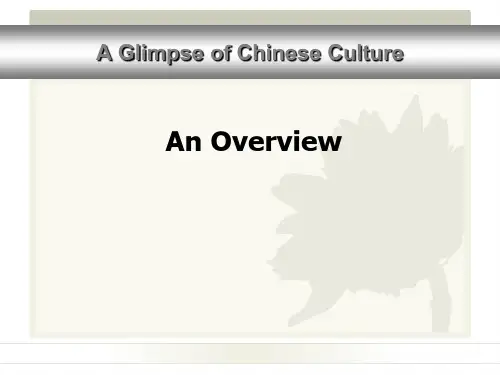
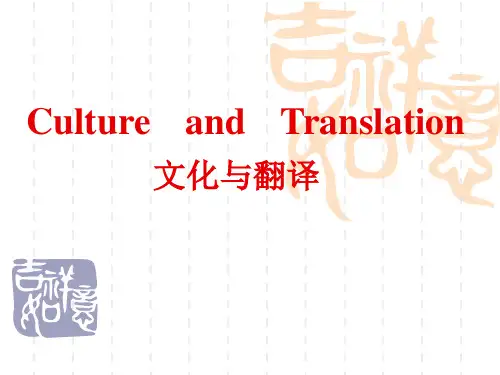
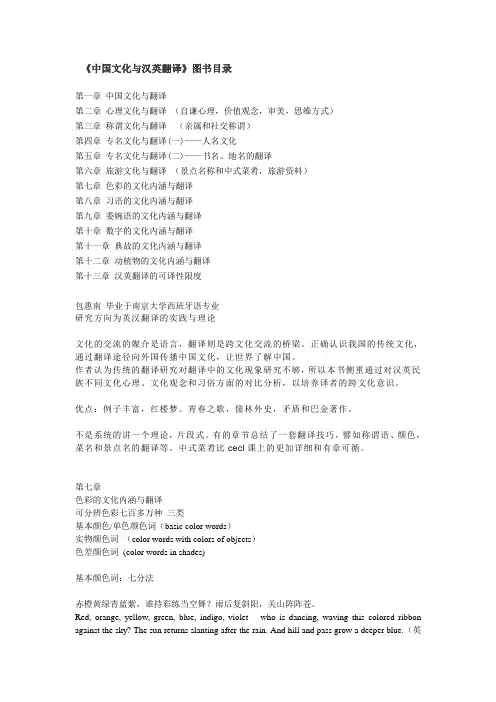
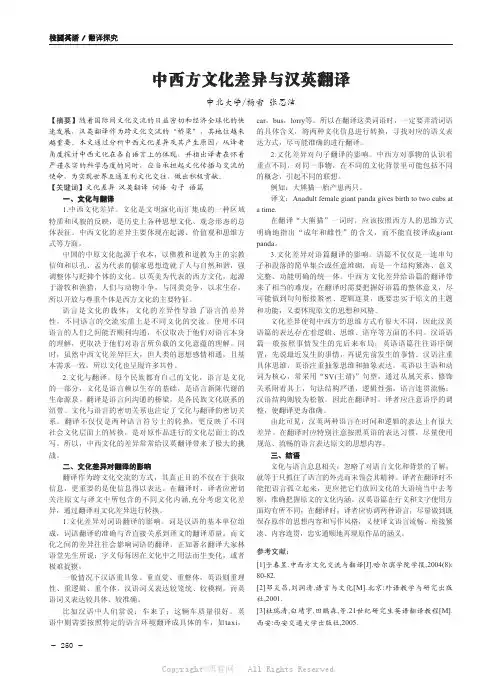
- 250-校园英语 / 翻译探究中西方文化差异与汉英翻译中北大学/杨雪 张思洁【摘要】随着国际间文化交流的日益密切和经济全球化的快速发展,汉英翻译作为跨文化交流的“桥梁”,其地位越来越重要。
本文通过分析中西文化差异及其产生原因,从译者角度探讨中西文化在各自语言上的体现,并指出译者在怀着严谨求实的科学态度的同时,应当承担起文化传播与交流的使命,为实现世界互通互利文化交往,做出积极贡献。
【关键词】文化差异 汉英翻译 词语 句子 语篇一、文化与翻译1.中西文化差异。
文化是文明演化而汇集成的一种区域特质和风貌的反映,是历史上各种思想文化、观念形态的总体表征。
中西文化的差异主要体现在起源、价值观和思维方式等方面。
中国的中原文化起源于农本,以佛教和道教为主的宗教信仰和以孔、孟为代表的儒家思想造就了人与自然和谐,强调整体与贬抑个体的文化。
以英美为代表的西方文化,起源于游牧和渔猎,人们与动物斗争,与同类竞争,以求生存,所以开放与尊重个体是西方文化的主要特征。
语言是文化的载体,文化的差异性导致了语言的差异性,不同语言的交流实质上是不同文化的交流。
使用不同语言的人们之间能否顺利沟通,不仅取决于他们对语言本身的理解,更取决于他们对语言所负载的文化意蕴的理解。
同时,虽然中西文化差异巨大,但人类的思想感情相通,且基本需求一致,所以文化也呈现许多共性。
2.文化与翻译。
每个民族都有自己的文化,语言是文化的一部分,文化是语言赖以生存的基础,是语言新陈代谢的生命源泉。
翻译是语言间沟通的桥梁,是各民族文化联系的纽带。
文化与语言的密切关系也注定了文化与翻译的密切关系。
翻译不仅仅是两种语言符号上的转换,更反映了不同社会文化层面上的转换,是对原作品进行的文化层面上的改写。
所以,中西文化的差异常常给汉英翻译带来了极大的挑战。
二、文化差异对翻译的影响翻译作为跨文化交流的方式,其真正目的不仅在于获取信息,更重要的是使信息得以表达。
在翻译时,译者应密切关注原文与译文中所包含的不同文化内涵,充分考虑文化差异,通过翻译对文化差异进行转换。
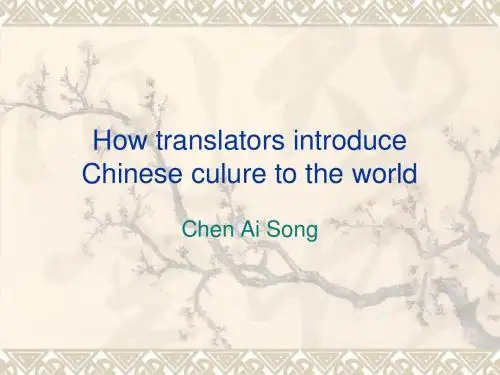
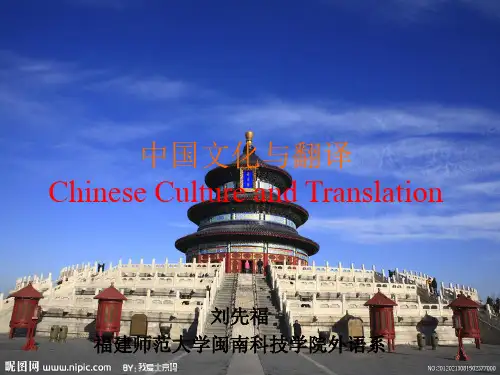
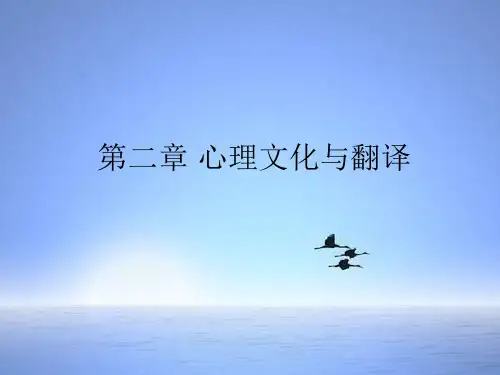
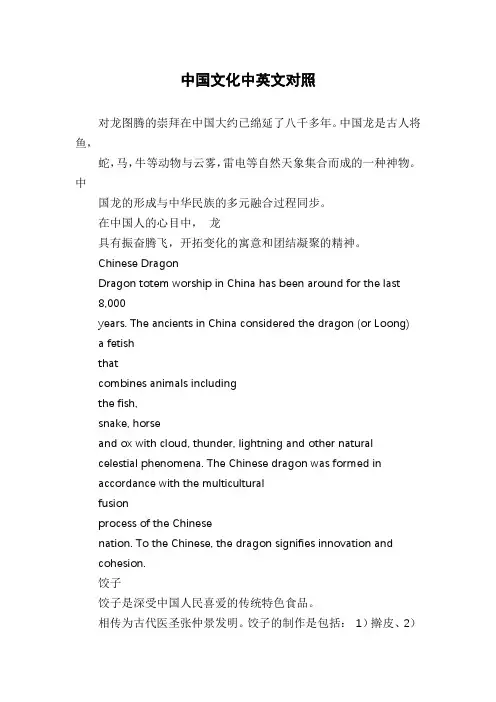
中国文化中英文对照对龙图腾的崇拜在中国大约已绵延了八千多年。
中国龙是古人将鱼,蛇,马,牛等动物与云雾,雷电等自然天象集合而成的一种神物。
中国龙的形成与中华民族的多元融合过程同步。
在中国人的心目中,龙具有振奋腾飞,开拓变化的寓意和团结凝聚的精神。
Chinese DragonDragon totem worship in China has been around for the last8,000years. The ancients in China considered the dragon (or Loong)a fetishthatcombines animals includingthe fish,snake, horseand ox with cloud, thunder, lightning and other naturalcelestial phenomena. The Chinese dragon was formed inaccordance with the multiculturalfusionprocess of the Chinesenation. To the Chinese, the dragon signifies innovation andcohesion.饺子饺子是深受中国人民喜爱的传统特色食品。
相传为古代医圣张仲景发明。
饺子的制作是包括:1)擀皮、2)备馅、3)包馅水煮三个步骤。
其特点是皮薄馅嫩,味道鲜美,形状独特,百食不厌。
民间有“ 好吃不过饺子" 的俗语。
中国人接亲待友。
逢年过节都有包饺子吃的习俗,寓意吉利。
对崇尚亲情的中国人来说," 更岁交子" 吃饺子,更是欢度页脚内容除夕、辞旧迎新必不可少的内容。
DumplingsDumplings are one of the Chinese people'sfavoritetraditionaldishes.According to an ancientChinese legend,dumplings werefirst made by the medical saint-Zhang Zhongjing. There arethree steps involved in making dumplings: 1) make dumplingwrappers out of dumpling flour; 2) prepare the dumplingstuffing;3) makedumplings and boilthem. With thinand elasticdough skin, freshen and tender stuffing, delicious taste, and unique shapes, dumplings are worth eating hundreds of times.There's an old saying that claims, "Nothing could be moredeliciousthan dumplings."During the Spring Festivaland otherholidaysor when treatingrelativesand friends,Chinese peoplelike to follow the auspicious custom of eating dumplings. ToChinese people who show high reverence for family love, having dumplings at the moment the old year is replaced by the new is an essential part of bidding farewell to the old and ushering in the New Year.针灸针灸是中医学的重要组成部分。
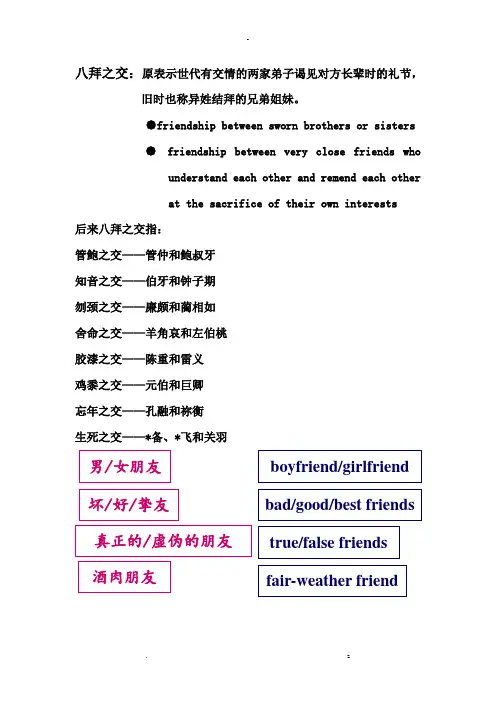
八拜之交:原表示世代有交情的两家弟子谒见对方长辈时的礼节,旧时也称异姓结拜的兄弟姐妹。
●friendship between sworn brothers or sisters●friendship between very close friends whounderstand each other and remend each otherat the sacrifice of their own interests莫逆之交:bosom friends总角之交:friendship between people who are friends since childhood一般作宾语,指儿时的朋友。
总角:古代未成年的人把头发扎成髻。
借指童年时期,幼年。
总角是八九岁至十三四岁的少年,古代儿童将头发分作左右两半,在头顶各扎成一个结,形如两个羊角,故称“总角〞。
贫贱之交:friendship between people who are poverty-stricken and from humble circumstances杵臼之交:friendship between people who do not care about the financial condition and social status of each other 杵:舂米的木棒;臼:石臼。
比喻交朋友不计较贫富和身分。
君子之交:friendship between gentlemen小人之交:friendship between villains狐朋狗友:people who often gather together doing something meaningless and even illegal棋友/牌友/球友:people who often meet to play chess, poker, ball. etc.战友:people who get to know each other while serving in the same army unit普通老百姓交的朋友谓“布衣之交〞;有钱人与没钱人交朋友谓“车笠之交〞;在逆境中结交的朋友称“患难之交〞;吃喝玩乐结交的朋友称“酒肉之交〞;年岁差异大,行辈不同而交情深厚的朋友称“忘年之交〞;幼年相交的朋友称“竹马之交〞;交情深厚的朋友谓“肺腑之交〞;亲密无间的朋友谓“胶漆之交〞;生死与共的朋友谓“生死之交〞;情投意合的朋友称“莫逆之交〞;哪怕砍头也不改变友谊的朋友称“刎颈之交〞;无意中相遇而结成的朋友称“邂逅之交〞;在道义上互相支持的朋友称“君子之交〞;只见过一次面,交情不深的朋友称“一面之交〞;仅点头打招呼,感情不深的朋友称“点头之交〞;平淡而浮泛交往的朋友称“泛泛之交〞;见过面但不熟悉的人称“半面之交〞;旧时结拜的兄弟姊妹称“八拜之交〞;交友不嫌贫贱称“杵逆之交〞;珍贵而有价值的交往称“金玉之交〞。
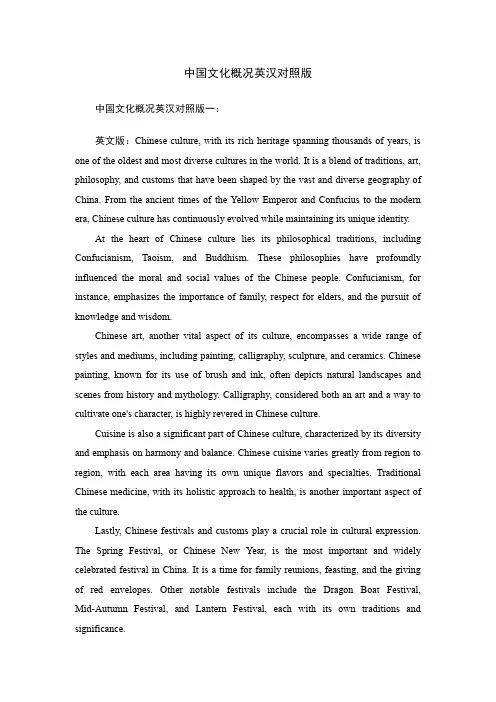
中国文化概况英汉对照版中国文化概况英汉对照版一:英文版:Chinese culture, with its rich heritage spanning thousands of years, is one of the oldest and most diverse cultures in the world. It is a blend of traditions, art, philosophy, and customs that have been shaped by the vast and diverse geography of China. From the ancient times of the Yellow Emperor and Confucius to the modern era, Chinese culture has continuously evolved while maintaining its unique identity.At the heart of Chinese culture lies its philosophical traditions, including Confucianism, Taoism, and Buddhism. These philosophies have profoundly influenced the moral and social values of the Chinese people. Confucianism, for instance, emphasizes the importance of family, respect for elders, and the pursuit of knowledge and wisdom.Chinese art, another vital aspect of its culture, encompasses a wide range of styles and mediums, including painting, calligraphy, sculpture, and ceramics. Chinese painting, known for its use of brush and ink, often depicts natural landscapes and scenes from history and mythology. Calligraphy, considered both an art and a way to cultivate one's character, is highly revered in Chinese culture.Cuisine is also a significant part of Chinese culture, characterized by its diversity and emphasis on harmony and balance. Chinese cuisine varies greatly from region to region, with each area having its own unique flavors and specialties. Traditional Chinese medicine, with its holistic approach to health, is another important aspect of the culture.Lastly, Chinese festivals and customs play a crucial role in cultural expression. The Spring Festival, or Chinese New Year, is the most important and widely celebrated festival in China. It is a time for family reunions, feasting, and the giving of red envelopes. Other notable festivals include the Dragon Boat Festival, Mid-Autumn Festival, and Lantern Festival, each with its own traditions and significance.汉语对照版:中国文化,拥有数千年的丰富遗产,是世界上最古老、最多样化的文化之一。
八拜之交:原表示世代有交情的两家弟子谒见对方长辈时的礼节,旧时也称异姓结拜的兄弟姐妹。
●friendship between sworn brothers or sisters●friendship between very close friends whounderstand each other and recommend eachother at the sacrifice of their own interests莫逆之交:bosom friends总角之交:friendship between people who are friends since childhood一般作宾语,指儿时的朋友。
总角:古代未成年的人把头发扎成髻。
借指童年时期,幼年。
总角是八九岁至十三四岁的少年,古代儿童将头发分作左右两半,在头顶各扎成一个结,形如两个羊角,故称“总角”。
贫贱之交:friendship between people who are poverty-stricken and from humble circumstances杵臼之交:friendship between people who do not care about the financial condition and social status of each other 杵:舂米的木棒;臼:石臼。
比喻交朋友不计较贫富和身分。
君子之交:friendship between gentlemen小人之交:friendship between villains狐朋狗友:people who often gather together doing something meaningless and even illegal棋友/牌友/球友:people who often meet to play chess, poker, ball. etc.战友:people who get to know each other while serving in the same army unit普通老百姓交的朋友谓“布衣之交”;有钱人与没钱人交朋友谓“车笠之交”;在逆境中结交的朋友称“患难之交”;吃喝玩乐结交的朋友称“酒肉之交”;年岁差别大,行辈不同而交情深厚的朋友称“忘年之交”;幼年相交的朋友称“竹马之交”;交情深厚的朋友谓“肺腑之交”;亲密无间的朋友谓“胶漆之交”;生死与共的朋友谓“生死之交”;情投意合的朋友称“莫逆之交”;哪怕砍头也不改变友谊的朋友称“刎颈之交”;无意中相遇而结成的朋友称“邂逅之交”;在道义上互相支持的朋友称“君子之交”;只见过一次面,交情不深的朋友称“一面之交”;仅点头打招呼,感情不深的朋友称“点头之交”;平淡而浮泛交往的朋友称“泛泛之交”;见过面但不熟悉的人称“半面之交”;旧时结拜的兄弟姊妹称“八拜之交”;交友不嫌贫贱称“杵逆之交”;宝贵而有价值的交往称“金玉之交”。
中国文化翻译-ChineseCulture1、中国酒文化Chinese Wine Culture中国人在7000年以前就开始用谷物酿酒。
总的来说,不管是古代还是现代,酒都和中国文化息息相关。
长久以来,中国的酒文化在人们生活中一直扮演着重要的角色。
我们的祖先在写诗时以酒助兴,在宴会中和亲朋好友敬酒。
作为一种文化形式,酒文化也是普通百姓生活中不可分割的部分,比如生日宴会、送别晚宴、婚礼庆典等。
Chinese people began to make spirits with grains seven thousand years ago. Generally speaking,wine has a close connection with culture in China in both ancient and modern times. Chinese wine culture has been playing a quite important role in Chinese people's life for a long time. Our Chinese ancestors used wine to enjoy themselves while writing poetry, or to make a toast to their relatives and friends during a feast. Wine culture, as a kind of culture form, is also an inseparable part in the life of ordinary Chinese people such as birthday party, farewell dinner, wedding, etc.2、中国书法Chinese Calligraphy中国书法历史悠久,它不仅是汉字的传统书写形式,也是体现自我修养和自我表达的艺术。
“中国文化翻译”课程教学大纲一、课程基本信息开课单位:翻译学院翻译系课程名称:中国文化翻译课程编号:224107英文名称:Chinese Culture and its English Translation课程类型:专业方向限选课总学时:36 理论学时:36 实验学时:学分:2开设专业:英语语言文学专业;翻译专业先修课程:无二、课程任务目标(一)课程任务本课程是面向英语语言文学专业(翻译方向)和翻译专业开设的一门专业方向限选课,属于文化通识类课程,一般在三年级或四年级开设。
本课程的任务是使学生既能把握中国文化的全貌及其内涵,又能学会用英文表达、介绍中国文化,为将来用英文传播中国文化打下初步的基础。
(二)课程目标在学完本课程之后,学生能够:1.了解中国文化的英文表达方式;2.用英语介绍中国文化的主要内容;3.比较中英文化的异同;4.了解文化与翻译的关系;5.为中国文化走出去的国家战略服务。
三、教学内容和要求第一章中国文化概述1.弄清文化的基本含义;2.了解中国的国庆节、国旗、国徽、国歌、首都以及地理概貌、历史概况、行政区划、人口、少数民族分布、政治体制以及经济发展与改革等基本信息;3.了解中国人口的优势、不足及其对策;4.了解中国经济发展与环保之间的关系;第二章中国的哲学与宗教1.了解中国哲学的演变和基本特点;2.了解中国宗教的演变和基本特点;3.比较中西哲学的异同;4.比较中西宗教的异同;5.了解宗教对中国语言、文化和思维的影响。
第三章中国文学1.了解中国古典文学、现代文学、当代文学三个时期重要作家的作品及其文学思想;2.了解中国四大名著的内容及其英译;3.了解莫言的作品及其英译问题。
第四章中国艺术1.了解中国的书画、传统戏曲、民间表演艺术以及传统乐器等知识;2.掌握主要中国艺术形式的英译;3.掌握以地名命名的文房四宝和戏曲名称英译的统一性问题。
第五章中国教育1.了解中国传统教育的历史演变过程;2.了解现代教育的特点;3.了解对外交流与合作的状况;4.掌握中国教育关键词的翻译问题。